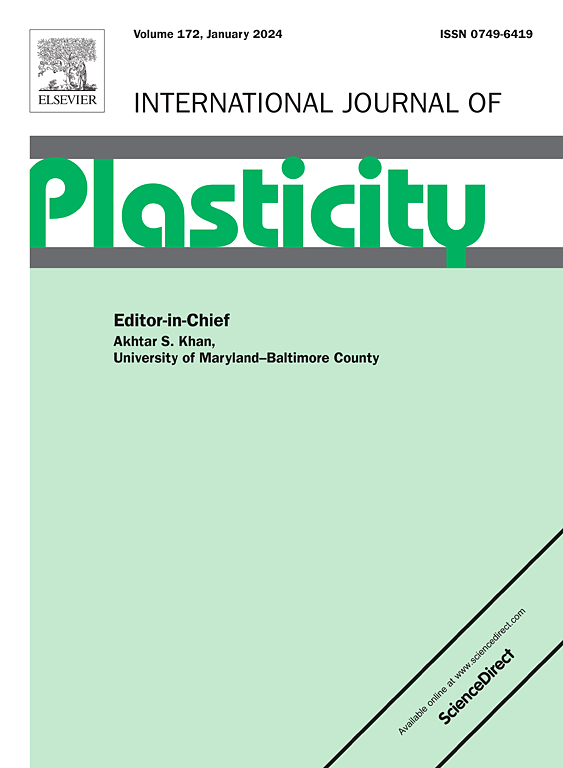通过异质组织设计减轻双相高熵合金中σ相的脆化
IF 9.4
1区 材料科学
Q1 ENGINEERING, MECHANICAL
引用次数: 0
摘要
双相高熵合金(HEAs)的设计通常涉及广泛的合金化,这可能导致拓扑紧密堆积(TCP)相的形成,从而显着降低拉伸延展性。平衡TCP相的高硬度,同时尽量减少其脆化效应是开发高性能HEAs的关键。本研究以脆性σ相为研究对象,提出了一种创新的非均质结构耦合设计策略,在增强σ相强化效果的同时将其脆性作用降到最低。采用具有sigma相的A (feccrni)90Al10 HEA作为模型材料,通过850℃5 min的短期高温退火工艺获得双峰相晶粒非均相结构。少量sigma相在再结晶(RX)区析出(~ 0.8 vol.%),调节了RX和非再结晶(NRX)区的硬度差异。这引起了显著的非均质变形诱导(HDI)应力,同时促进了区域之间的协调变形,从而引发了连续的加工硬化和塑性变形。因此,HEA表现出高强度(1412 MPa)和延性(14.9%)的优异组合。潜在的变形机制是HDI应力驱动下的应变硬化,强化了RX区域,使sigma相与FCC基体之间的局部应变失配最小化,抑制了界面裂纹的形核和扩展。本方法为易受TCP相形成影响的金属材料的强度和延展性共同设计提供了一条有前途的途径。本文章由计算机程序翻译,如有差异,请以英文原文为准。


Mitigating embrittlement of sigma phase in dual-phase high-entropy alloys through heterostructure design
The design of dual-phase high-entropy alloys (HEAs) often involves extensive alloying, which can lead to the formation of topologically close-packed (TCP) phases, significantly reducing tensile ductility. Balancing the high hardness of TCP phases while minimizing their embrittling effects is crucial for developing high-performance HEAs. This study, which focuses on the brittle sigma phase, proposes an innovative heterogeneous structural coupling design strategy that simultaneously enhances the strengthening effect of the sigma phase while minimizing its embrittlement role. A (FeCoCrNi)90Al10 HEA with sigma phase is employed as the model material, where a bimodal grain heterogeneous structure is achieved through a short-term high-temperature annealing process at 850 °C for 5 min. A small amount of sigma phase precipitates (∼0.8 vol.%) in the recrystallization (RX) region, modulating the hardness difference between the RX and non-recrystallized (NRX) regions. This induces significant heterogeneous deformation-induced (HDI) stress, while promoting coordinated deformation between regions, thereby triggering continuous work hardening and plastic deformation. As a result, the HEA exhibits an exceptional combination of high strength (1412 MPa) and ductility (14.9 %). The underlying deformation mechanism involves strain hardening driven by HDI stress, which strengthens the RX region and minimizes local strain mismatch between the sigma phase and the FCC matrix, suppressing the nucleation and propagation of interfacial cracks. The present approach presents a promising pathway for co-designing strength and ductility in metallic materials susceptible to TCP phase formation.
求助全文
通过发布文献求助,成功后即可免费获取论文全文。
去求助
来源期刊

International Journal of Plasticity
工程技术-材料科学:综合
CiteScore
15.30
自引率
26.50%
发文量
256
审稿时长
46 days
期刊介绍:
International Journal of Plasticity aims to present original research encompassing all facets of plastic deformation, damage, and fracture behavior in both isotropic and anisotropic solids. This includes exploring the thermodynamics of plasticity and fracture, continuum theory, and macroscopic as well as microscopic phenomena.
Topics of interest span the plastic behavior of single crystals and polycrystalline metals, ceramics, rocks, soils, composites, nanocrystalline and microelectronics materials, shape memory alloys, ferroelectric ceramics, thin films, and polymers. Additionally, the journal covers plasticity aspects of failure and fracture mechanics. Contributions involving significant experimental, numerical, or theoretical advancements that enhance the understanding of the plastic behavior of solids are particularly valued. Papers addressing the modeling of finite nonlinear elastic deformation, bearing similarities to the modeling of plastic deformation, are also welcomed.
 求助内容:
求助内容: 应助结果提醒方式:
应助结果提醒方式:


